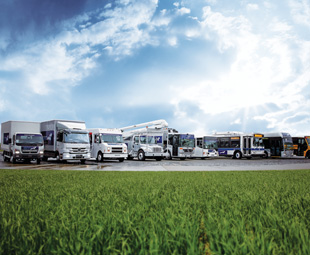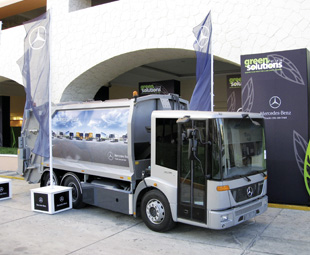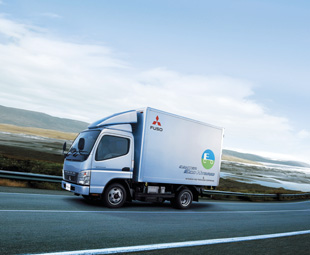I see the future

Many auto manufacturers took the lead from COP17 to launch and showcase various environmentally friendly products and initiatives. Mercedes-Benz hosted a particularly interesting “green vehicles day” for local journalists to experience theirs first-hand. GAVIN MYERS was one of them…
November 2011 and the world’s eyes are on South Africa and its COP17 (17th Conference of the Parties) conference in Durban. “Green” is the word and everyone – not least of whom various motor manufacturers – is keen to show off what they have to offer for the future. In line with that, Mercedes-Benz, certainly a leader in this regard, was keen to take us on a journey down its “road to emission-free driving”.
We already know Mercedes-Benz is among the leaders in the commercial vehicle market, especially in Europe, where the new Euro-6 Actros (see FOCUS, November 2011) brings operators fuel savings of between six and nine percent and has just been named the 2012 Truck of the Year, becoming the first vehicle to receive the award for the fourth time. Locally, a few operators are also taking up the gauntlet and latching on to the company’s higher-spec products, such as the Unitrans LPG Actros (reported on in December 2011) and Triton Express’ range of Euro-5 BlueTEC Ategos, which we will feature next month.
“We enjoy a sense of satisfaction that a number of our operators have had the foresight to actively take part in these emission-reducing technologies and, together with us, shape the overall environment in South Africa,” says Mercedes-Benz South Africa president and CEO, Dr Martin Zimmerman.
 And he’s right. However, the initiative really shouldn’t be up to individual operators. But, as we know, the widespread implementation of such technologies requires ready availability of low-sulphur fuels, an area where South Africa lags. Happily, though, Mercedes-Benz is taking the initiative and introducing to the market a number of alternative drive technologies, many of which will make their way on to roads countrywide in the not too distant future.
And he’s right. However, the initiative really shouldn’t be up to individual operators. But, as we know, the widespread implementation of such technologies requires ready availability of low-sulphur fuels, an area where South Africa lags. Happily, though, Mercedes-Benz is taking the initiative and introducing to the market a number of alternative drive technologies, many of which will make their way on to roads countrywide in the not too distant future.
The company has developed a “modular drive mix” – its three-lane road towards zero emissions. Lane one constitutes efficient, hi-tech internal combustion engines and the drive to make them greener, together with specific vehicle optimisation initiatives in areas such as aerodynamics, lightweight design and energy management. Lane two the company sees as being occupied by hybrid drive technology. Finally, lane three, belonging to electric mobility – whether battery or fuel cell powered – that results in full zero-emission vehicles. Parent company Daimler sees that mix shaping the dynamic of road traffic for the foreseeable future. We were privileged to sample products representing each “lane”.
Representing lane one is the soon to be launched Econic 1828 NGT. This natural gas-drive truck was shown to visitors at last year’s Johannesburg International Motor Show (JIMS) and it’s as impressive to sample as it is to behold. Originally launched in 1998, with the natural gas-engined option available from 2002, the idea behind the Econic was to offer an environmentally friendly, low-floor transport vehicle for municipal transportation, consolidation and local distribution, specifically within inner-city areas. More than 10 000 Econic trucks have been sold, 10 percent of those the NGT variant.
The Econic NGT is powered by the six-cylinder 900-series mono-fuel natural gas-drive engine, the 6,9 litre unit delivering 205 kW. The emissions produced by the Econic NGT don’t contain any fine dust or particles. In addition, the gas-drive engine also boasts low noise emissions of a paltry 72 dBA.
 The low-floor cab features a large wraparound windshield and a co-driver’s door that opens automatically at the push of a button. The cab is extremely spacious, featuring a level floor and three-abreast seating with plenty of headroom – ideal for applications involving frequent entering and alighting. Furthermore, its electronically controlled Allison automatic transmission, combined with exceptional visibility, makes piloting the vehicle a breeze.
The low-floor cab features a large wraparound windshield and a co-driver’s door that opens automatically at the push of a button. The cab is extremely spacious, featuring a level floor and three-abreast seating with plenty of headroom – ideal for applications involving frequent entering and alighting. Furthermore, its electronically controlled Allison automatic transmission, combined with exceptional visibility, makes piloting the vehicle a breeze.
Almost as easy as changing lanes, in this case to lane two, where we encounter the Mitsubishi Fuso Canter Eco Hybrid. To be launched later this year, this 6,5 tonne vehicle also attracted much attention at JIMS. With a three-tonne payload, combined with the economical operation of its hybrid-drive system (in this case, making use of a Euro 4-compliant diesel engine), the Canter Eco Hybrid is seen as an ideal urban delivery vehicle that lends itself to the stop-start monotony of such driving.
Vis-à-vis, energy from braking is turned into heat, which in turn is used to power a generator that charges the lithium-ion (Li-io) battery. Energy from the battery is used to get the vehicle moving from rest. Given a sufficiently charged battery the engine will switch off as soon as the truck stops or idles for more than 15 seconds, saving fuel and reducing emissions.
The Canter Eco Hybrid’s electrically aided drive system leads us nicely into lane three, where we find the fully-electric Vito E-CELL panel van. This is the first van of its kind to roll off the series production line in Vittoria, Spain, along with other run-of-the-mill Vitos. The Vito E-CELL asks for no compromise from the user, with an unrestricted load compartment allowing a payload of 900 kg, thanks to batteries stored beneath the load-compartment floor.
These Li-io batteries have a high current capacity of 36 kWh, sufficient for a range of around 130 km. They power a 60 kW, 280 Nm electric motor, allowing the van a limited top speed of 80 km/h. Driving the vehicle (albeit unladen) you notice how its performance is easily on par with that of the rest of the diesel-engined range, the van gathering momentum in a capable and eerily silent manner. Unfortunately, MBSA will not be bringing this vehicle to our shores any time soon.
“In line with our parent company Daimler, we want to provide our South African customers with fuel-efficient and environmentally sustainable vehicles,” says Zimmerman. “We’re making our trucks greener, thereby helping our professional customers to make their businesses even better.”
It is technologies such as these that allow Daimler and Mercedes-Benz to tackle automotive responsibilities so pertinent to our times with aplomb. “In addition,” says Zimmerman, “we take a preventative approach to environmental protection by systematically including all stages of the vehicle manufacturing process, as well as the complete product lifecycle – from development to recycling.”
Yes, green is the word. And Mercedes-Benz is leading the way down the road to emission-free mobility.
Published by
Focus on Transport
focusmagsa


 !
From 1 Apri
!
From 1 Apri

 Big news from FOCUS on Transport + Logist
Big news from FOCUS on Transport + Logist





 FUSO: Driving the Future of Mobile Healthc
FUSO: Driving the Future of Mobile Healthc



 A brand
A brand




 Wondering about the maximum legal load for a
Wondering about the maximum legal load for a 
 The MAN hTGX powered by a hydrogen combus
The MAN hTGX powered by a hydrogen combus

 Exciting News for South African Operators
Exciting News for South African Operators
